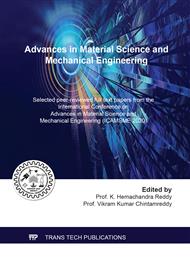[1]
A.K. Zahid, N.S. Arshad, Z.K. Noor, K. Urfi, G.A. Quadir, Multi response optimization of wire electrical discharge machining process parameters using Taguchi based grey relational analysis. Procedia Mater. Sci. 6 (2014) 1683-1695.
DOI: 10.1016/j.mspro.2014.07.154
Google Scholar
[2]
A.V.S. Ramprasad, K. Ramji, G.L. Datta, An experimental study on Wire EDM on Ti-6Al-4V alloy. Procedia Mater. Sci. 5 (2014) 2567-2576.
DOI: 10.1016/j.mspro.2014.07.517
Google Scholar
[3]
V. Upadhyay, P.K. Jain, N.K. Mehta, Artificial neural network modelling of cutting forces in turning of Ti-6Al-4V alloy and its comparison with response surface methodology. Proceedings of International Conference on SocPros. (2011) 761-768.
DOI: 10.1007/978-81-322-0491-6_69
Google Scholar
[4]
F. Yinsheng, C. Li, J. Bai, Q. Li, Experimental study on energy consumption of energy saving pulse power for WEDM. Int. J. Adv. Manuf. Technol. 72 (2014) 1687-1691.
DOI: 10.1007/s00170-014-5791-x
Google Scholar
[5]
P. SalmanP, D. Ibrahim, D. Basil, Power consumption and tool wear assessment when machining Titanium alloys. Int. J. Prec. Eng. Manuf. 14 (2013) 925-936.
DOI: 10.1007/s12541-013-0122-y
Google Scholar
[6]
A. Dasgupta, P. Dutta, M. Majumder, S.C. Panja, Impact of change in machining time, MRR in WEDM modelled by ANN-RSM. J. Indus. Eng. Adv. 2(1) (2017) 1-13.
Google Scholar
[7]
S.S. Mahapatra, P. Amar, Parametric optimization of wire electrical discharge machining (WEDM) process using Taguchi method. J. Braz. Soc. Mech. Sci. Eng. 28(4) (2006) 422-429.
DOI: 10.1590/s1678-58782006000400006
Google Scholar
[8]
Makkapati S, Reddy MR, Joshi B, Praveen JP, Rao BN. Optimum WEDM process parameters of Incoloy alloy800 using Taguchi method. Int. J. Ind., Manuf. Sys. Eng. 1(3) (2016) 64-68.
Google Scholar
[9]
V. Muthukumar, B.A. Suresh, R. Venkatasamy, M. Raajenthiren, Optimization of the WEDM parameters on machining Incoloy 800 super alloy with multiple quality characteristics. Int. J. Sci. Eng. Tech. 2(6) (2010) 1538-1547.
Google Scholar
[10]
A. Mandal, A.R. Dixit, A.K. Das, N. Mandal, Modeling and optimization of machining Nimonic C-263 super alloy using multi cut strategy in WEDM. Mater. Manuf. Processes. 31 (2016) 860–868.
DOI: 10.1080/10426914.2015.1048462
Google Scholar
[11]
H.R. Tonday, A.M. Tigga, Analysis of effects of cutting parameters of wire electrical discharge machining on material removal rate and surface integrity. IOP Conf. Ser. Mater. Sci. Eng. 115 (2016) 1-7.
DOI: 10.1088/1757-899x/115/1/012013
Google Scholar
[12]
D. Devarasiddappa, M. Chandrasekaran, Evaluation of power consumption and MRR in WEDM of Ti–6Al–4V alloy and its simultaneous optimization for sustainable production. J. Braz. Soc. Mech. Sci. Eng. 40 (400) (2018).
DOI: 10.1007/s40430-018-1318-y
Google Scholar
[13]
S. Choudhary, K. Kant, P. Saini, Analysis of MRR and SR with different electrode for SS 316 on die-sinking EDM using Taguchi technique. Glob. J. Res. Eng., Mech. Mecs. Eng. 13(3) (2013) 15-21.
Google Scholar
[14]
S.F. Miller, J.S. Albert, J. Qu, Investigation of the spark cycle on material removal rate in wire electrical discharge machining of advanced materials. Int. J. Mach. Tool. Manuf. 44 (2004) 391-400.
DOI: 10.1016/j.ijmachtools.2003.10.005
Google Scholar


